Saint-Gobain Bundle
Who Buys From Saint-Gobain?
From the opulent halls of Versailles to modern sustainable buildings, Saint-Gobain's story is one of remarkable transformation. But who are the people and businesses driving the company's success today? Understanding the Saint-Gobain SWOT Analysis is key to grasping its market position. This exploration delves into the crucial aspects of Saint-Gobain's customer demographics and target market, revealing the diverse clientele fueling its global operations.
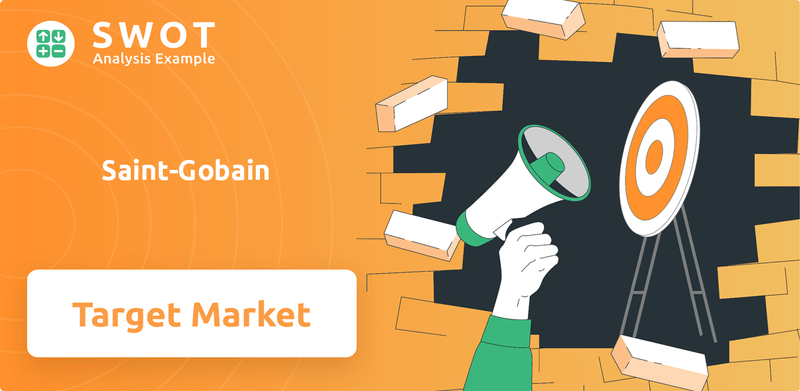
This deep dive into Saint-Gobain's customer profile goes beyond a simple demographic analysis. We'll examine Saint-Gobain's market segmentation strategy, exploring the industries it serves and the geographic locations of its target market. Furthermore, we'll uncover Saint-Gobain customer needs and preferences, offering insights into how the company adapts its offerings to meet the demands of its diverse customer base, from construction materials to automotive glass, ensuring continued relevance and success in the global market.
Who Are Saint-Gobain’s Main Customers?
Understanding the customer demographics and target market of the company involves recognizing its dual approach to business. The company primarily operates in the business-to-business (B2B) sector, serving various industries such as construction, mobility, healthcare, and industrial markets. However, the company is also expanding its business-to-consumer (B2C) presence, particularly in high-growth regions like India.
The company's B2B target market includes construction companies, architects, contractors, manufacturers, and large industrial clients. These customers utilize the company's products, such as flat glass, insulation, gypsum, abrasives, ceramics, and plastics, in their projects and products. The characteristics of these clients are defined by their industry, project scale, and technical requirements. The company's focus on sustainable and high-performance solutions also plays a significant role in attracting these customers.
The company's strategic shift towards the B2C market is evident in regions like India, where it offers home improvement products directly to consumers. This expansion is driven by opportunities in the home improvement market and the company's strengths in design, manufacturing, and distribution. This strategic move is expected to increase the B2C revenue proportion, with investments planned for expansion and acquisitions.
The B2B customers are primarily defined by their industry, project scale, and technical needs. They often seek sustainable and high-performance solutions. The company's products are used in construction, manufacturing, and various industrial applications. The company focuses on providing materials and solutions tailored to these specific requirements.
The company is actively expanding its B2C presence, especially in regions like India. This expansion involves offering products like windows, shower cubicles, and mirrors directly to consumers. The company is investing in both greenfield and brownfield expansions, as well as acquisitions. This strategic move is driven by opportunities in the home improvement market.
North America is the largest region for the company in terms of operating income. The company is strategically expanding into high-growth geographies. Recent acquisitions in 2024, such as CSR in Australia and FOSROC in India, highlight this geographic focus. These acquisitions are projected to add to sales and operating profit in 2025.
The company saw strong performance in the North American renovation market in 2024. Acquisitions are expected to boost sales and operating profit. The company's strategic investments and expansions are aimed at increasing its market share. The B2C segment is expected to grow with strategic investments.
The company's market segmentation strategy involves a dual approach, targeting both B2B and B2C segments. The B2B segment focuses on industries like construction and manufacturing, while the B2C segment targets the home improvement market. The company's strategy includes geographic expansion and strategic acquisitions. The company aims to increase its B2C revenue through targeted investments and expansions.
- The company's B2B customers are construction companies, architects, contractors, and manufacturers.
- The B2C market is targeted through home improvement products in regions like India.
- Geographic expansion includes acquisitions in North America, Australia, and India.
- The company's strategy focuses on sustainable and high-performance solutions.
For more insights into the company's financial structure and business model, you can explore Revenue Streams & Business Model of Saint-Gobain.
Saint-Gobain SWOT Analysis
- Complete SWOT Breakdown
- Fully Customizable
- Editable in Excel & Word
- Professional Formatting
- Investor-Ready Format
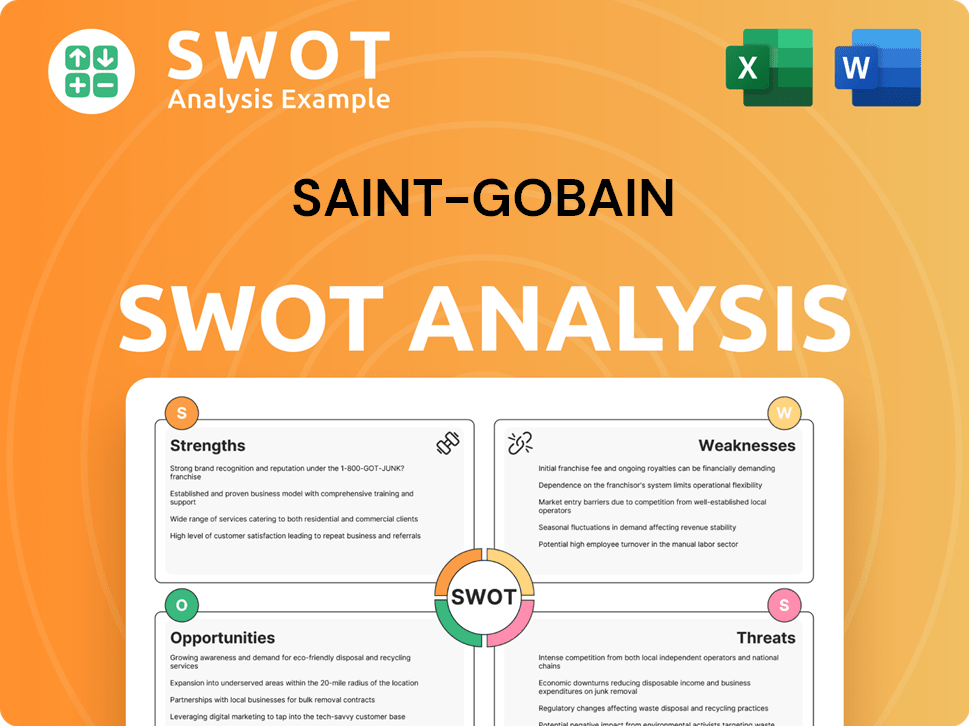
What Do Saint-Gobain’s Customers Want?
Understanding the customer needs and preferences of Saint-Gobain is crucial for grasping its market positioning. The company's success hinges on its ability to meet the evolving demands of its diverse customer base. This involves a deep dive into the customer demographics and target market to tailor products and services effectively.
Saint-Gobain's customers are driven by a blend of practical, economic, and sustainability-focused considerations. These factors influence purchasing decisions across various segments, from construction to automotive. The company's approach to market segmentation allows it to cater to specific needs, ensuring relevance and competitiveness.
A key driver for Saint-Gobain customers is the demand for high-performance and sustainable solutions. This is particularly evident in the construction sector, where there's a pressing need for sustainable practices. Customers are increasingly seeking products that contribute to health, well-being, and climate resilience.
Energy efficiency is a significant factor influencing purchasing behavior. Approximately 35% of stakeholders prioritize energy-efficient solutions when making decisions. This highlights the importance of products that reduce energy consumption.
The use of eco-friendly materials is another key consideration for customers. About 31% of stakeholders cite the use of eco-friendly materials as important. This trend underscores the growing demand for sustainable products.
Resilience to climatic hazards has gained significant importance, increasing by 8 points compared to 2024, reaching 21%. This reflects the growing need for products that can withstand extreme weather conditions.
Saint-Gobain addresses these needs through innovation, such as low-carbon glass (ORAÉ®), which reduces CO2 emissions by 42%. The company also offers very low-carbon plaster, especially in markets like India.
Customer feedback and market trends heavily influence Saint-Gobain's product development. The company's decentralized R&D teams collaborate with marketing teams to tailor innovations to local needs.
Saint-Gobain has a strong presence in the renovation market, with over 50% of sales coming from this sector. In China, the company is focusing on the resilient renovation sector, leveraging products like FORTIFIED Roof™ systems.
Saint-Gobain's approach to meeting customer needs involves several key strategies. These strategies ensure the company remains competitive and responsive to market changes. A deeper understanding of the Growth Strategy of Saint-Gobain can provide further insights.
- Innovation and Sustainability: Continuously developing and offering integrated, differentiated, and sustainable solutions.
- Market Research: Utilizing the Sustainable Construction Barometer to identify pain points and unmet needs in the industry.
- Tailored Solutions: Providing comprehensive solutions that cater to specific market segments and regional conditions.
- Adaptability: Swiftly adapting to regional market conditions through its 'country-by-country model'.
Saint-Gobain PESTLE Analysis
- Covers All 6 PESTLE Categories
- No Research Needed – Save Hours of Work
- Built by Experts, Trusted by Consultants
- Instant Download, Ready to Use
- 100% Editable, Fully Customizable
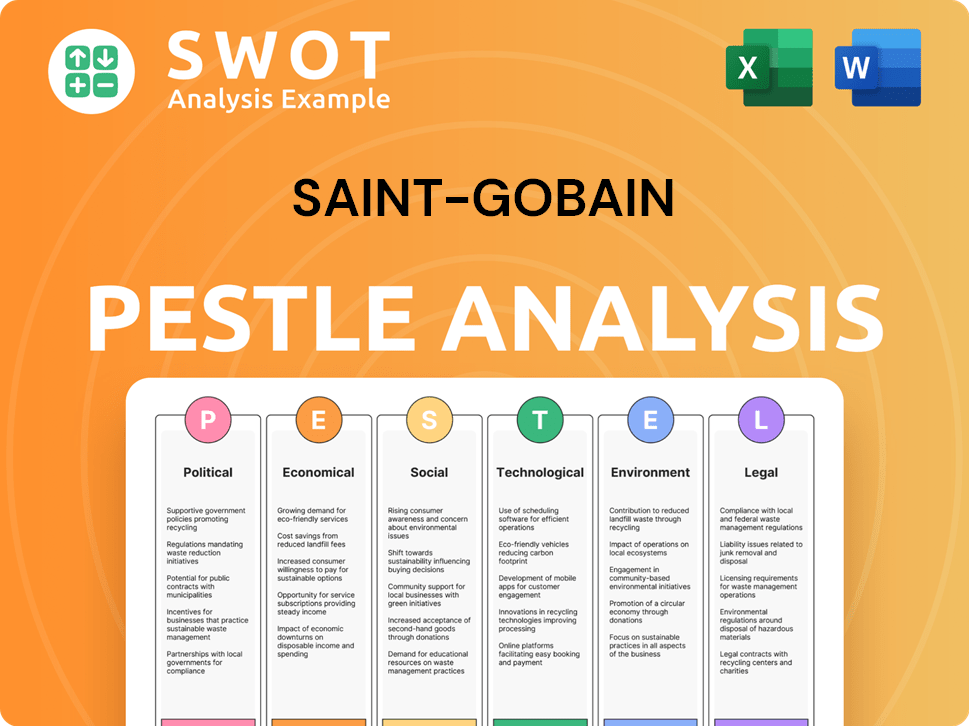
Where does Saint-Gobain operate?
The geographical market presence of Saint-Gobain is a key element of its strategy, focusing on global expansion and diversification. In 2024, over two-thirds of the company's pro forma operating income came from high-growth regions, demonstrating a strategic focus on these areas. This approach allows the company to tap into diverse markets and mitigate risks associated with economic fluctuations in any single region. Understanding the Growth Strategy of Saint-Gobain is crucial to see how they operate globally.
North America is the largest region for Saint-Gobain in terms of operating income, contributing significantly to its overall financial performance. The company has a strong presence in the United States and Canada, serving local construction markets through numerous facilities. This strong foothold in North America highlights the importance of this market for the company's overall strategy. The company's approach includes localizing offerings and partnerships to succeed in diverse markets.
The Asia-Pacific region and emerging countries are also vital to Saint-Gobain's growth, with significant sales increases in 2024, particularly in India. The company's strategy involves adapting to regional market conditions and using local value chains. Recent acquisitions, such as CSR in Australia and FOSROC in India, align with the company's worldwide leadership in sustainable construction. This strategy helps the company to be ideally positioned in local construction markets and avoids direct exposure to customs tariffs.
North America remains the largest market for Saint-Gobain, accounting for 34% of the group's operating income in 2024. The company operates 58 plants in the US and 33 facilities in Canada, serving local construction markets. This strong presence highlights the importance of the region.
The Asia-Pacific region saw robust sales growth and operating margin in 2024, driven by strong performance in India. India experienced approximately 10% volume growth. The integration of CSR in Australia is also contributing to growth in this region.
Latin America is showing improving trends, with the acquisition of Cemix strengthening Saint-Gobain's construction chemicals presence in Mexico and Central America. This expansion enhances its market position in the region. The company is focused on worldwide leadership in light and sustainable construction.
Europe, while facing challenges in new construction, remains a significant market. The company anticipates a gradual recovery in the second half of 2025. Southern Europe, the Middle East, and Africa saw a 7.3% sales decline in 2024, while France performed well due to renovation demand.
Saint-Gobain has strategically expanded its footprint through acquisitions and optimized its portfolio through disposals. These actions are designed to strengthen its market position and focus on key growth areas.
- Four major acquisitions finalized in the last 12 months, totaling €5 billion.
- Acquisitions include CSR in Australia, Bailey in Canada, OVNIVER (Cemix brand) in Mexico, and FOSROC in India and the Middle East.
- The company has also divested businesses, such as the pipe drainage business (PAM Building).
Saint-Gobain Business Model Canvas
- Complete 9-Block Business Model Canvas
- Effortlessly Communicate Your Business Strategy
- Investor-Ready BMC Format
- 100% Editable and Customizable
- Clear and Structured Layout
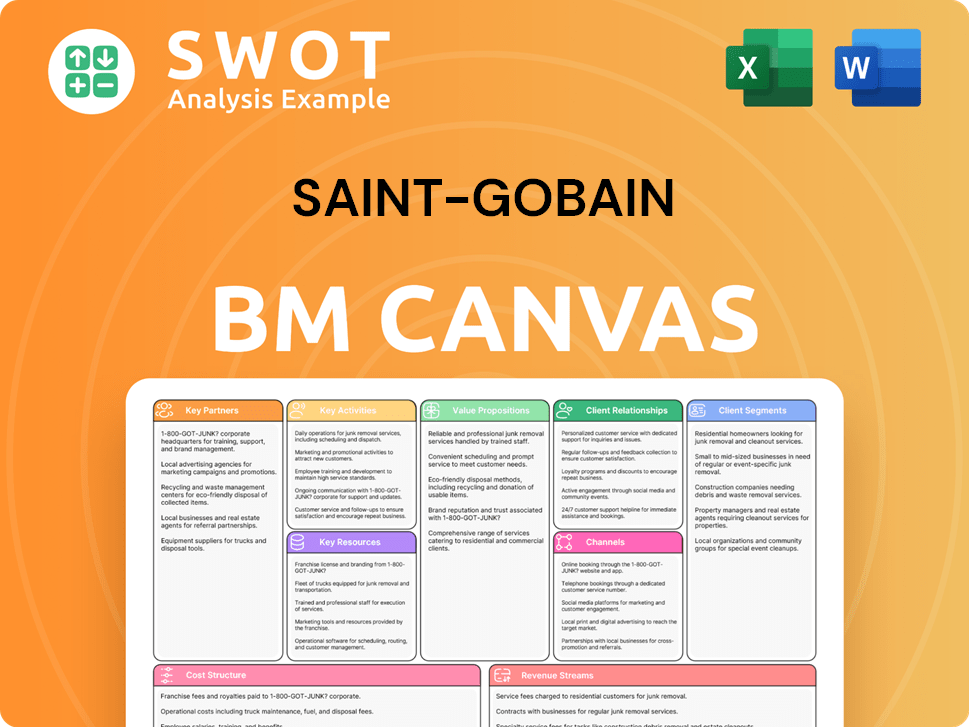
How Does Saint-Gobain Win & Keep Customers?
Saint-Gobain's customer acquisition and retention strategies are designed to leverage its global presence and diverse product offerings. The company focuses on strategic acquisitions, particularly in high-growth regions and key product segments, to expand its customer base. Simultaneously, it emphasizes sustainable and innovative solutions to retain customers, aligning with the growing demand for environmentally responsible products. This approach is tailored to both B2B and B2C segments, ensuring a localized and customer-centric strategy.
The company's strategy includes significant acquisitions to broaden its market reach. These acquisitions, such as CSR in Australia, Bailey in Canada, OVNIVER (Cemix brand) in Mexico, and FOSROC in India and the Middle East, are expected to contribute to its sales and operating profit in 2025. For customer retention, Saint-Gobain focuses on providing integrated and differentiated solutions, especially those related to sustainability, a critical factor in today's market. The company's approach is adapted to the needs of its various customer segments, ensuring that it can meet their specific requirements effectively.
Marketing and sales tactics are customized to meet the specific needs of each region and market segment. The company's decentralized model, along with its local performance-driven organization, allows it to build strong relationships with contractors, architects, and industrial clients in the B2B sector. In the B2C segment, particularly in India, the company is offering home improvement solutions directly to consumers. This implies a focus on accessibility and convenience.
Saint-Gobain's primary customer acquisition strategy involves strategic acquisitions in high-growth regions and key product segments. In 2024, the company finalized four major acquisitions, investing a total of €5 billion. These acquisitions include CSR, Bailey, OVNIVER, and FOSROC, which are projected to boost sales and operating profit.
The company emphasizes its comprehensive range of integrated, differentiated, and innovative solutions, with a strong focus on sustainability. This approach includes initiatives like the Sustainable Construction Observatory and the annual Sustainable Construction Barometer. This focus resonates with customers seeking environmentally responsible solutions.
Saint-Gobain's 'country-by-country model' and local value chains highlight a strong focus on localized customer support and tailored solutions. This approach allows the company to quickly adapt to market changes and outperform competitors. Local teams ensure that the company can meet the needs of its customers effectively.
The company's continuous innovation process and efforts to understand customer needs and preferences implicitly support the role of customer data and CRM systems. R&D teams work closely with marketing to tailor innovations to local customer needs. This suggest a data-informed approach to product development and customer engagement.
Saint-Gobain's customer acquisition and retention strategies are multifaceted, focusing on strategic acquisitions, sustainable solutions, and localized support. These strategies have led to positive financial outcomes.
- Acquisitions: In 2024, Saint-Gobain made acquisitions totaling €5 billion. These acquisitions are expected to add 3% to sales and €200 million to operating profit in 2025.
- Sustainability Focus: The company's emphasis on sustainable construction and related initiatives resonates with customers seeking environmentally responsible solutions.
- Local Approach: The country-by-country model and local value chains enable tailored solutions, supporting customer loyalty.
- Financial Performance: The company's operating margin reached 11.4% in 2024, with an outlook of over 11.0% in 2025.
Saint-Gobain Porter's Five Forces Analysis
- Covers All 5 Competitive Forces in Detail
- Structured for Consultants, Students, and Founders
- 100% Editable in Microsoft Word & Excel
- Instant Digital Download – Use Immediately
- Compatible with Mac & PC – Fully Unlocked
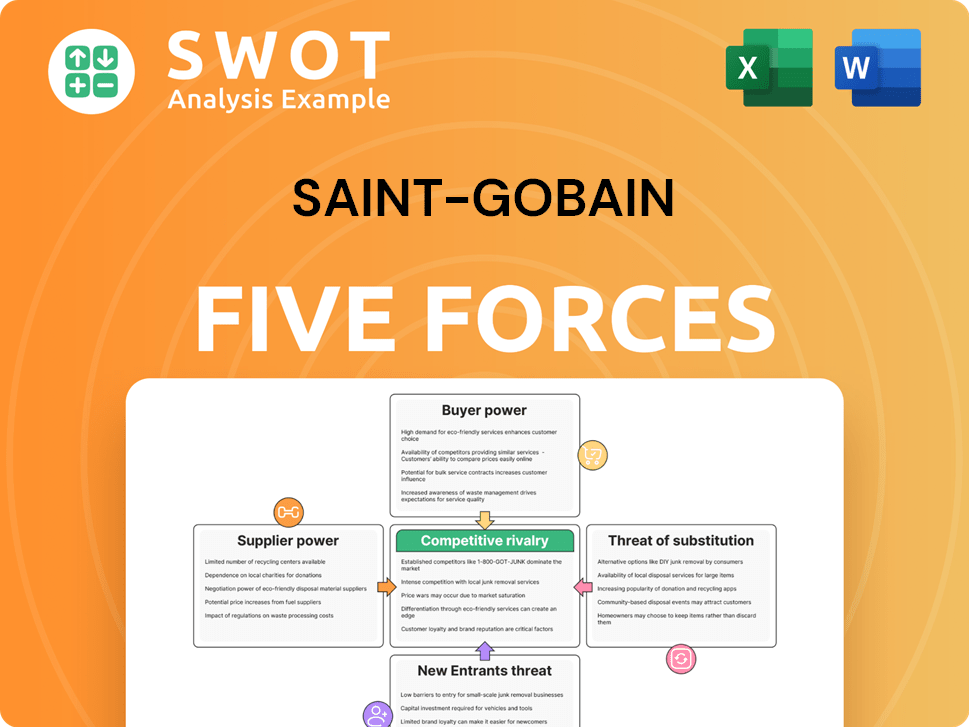
Related Blogs
- What are Mission Vision & Core Values of Saint-Gobain Company?
- What is Competitive Landscape of Saint-Gobain Company?
- What is Growth Strategy and Future Prospects of Saint-Gobain Company?
- How Does Saint-Gobain Company Work?
- What is Sales and Marketing Strategy of Saint-Gobain Company?
- What is Brief History of Saint-Gobain Company?
- Who Owns Saint-Gobain Company?
Disclaimer
All information, articles, and product details provided on this website are for general informational and educational purposes only. We do not claim any ownership over, nor do we intend to infringe upon, any trademarks, copyrights, logos, brand names, or other intellectual property mentioned or depicted on this site. Such intellectual property remains the property of its respective owners, and any references here are made solely for identification or informational purposes, without implying any affiliation, endorsement, or partnership.
We make no representations or warranties, express or implied, regarding the accuracy, completeness, or suitability of any content or products presented. Nothing on this website should be construed as legal, tax, investment, financial, medical, or other professional advice. In addition, no part of this site—including articles or product references—constitutes a solicitation, recommendation, endorsement, advertisement, or offer to buy or sell any securities, franchises, or other financial instruments, particularly in jurisdictions where such activity would be unlawful.
All content is of a general nature and may not address the specific circumstances of any individual or entity. It is not a substitute for professional advice or services. Any actions you take based on the information provided here are strictly at your own risk. You accept full responsibility for any decisions or outcomes arising from your use of this website and agree to release us from any liability in connection with your use of, or reliance upon, the content or products found herein.